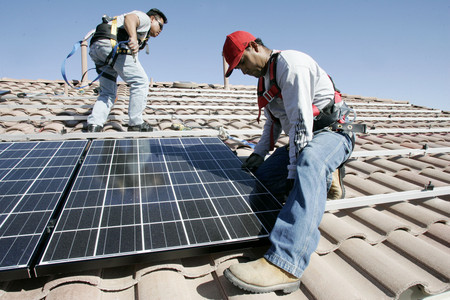Get It While It’s Hot

NEW YORK — Jillian Lung says she’s no environmentalist. Still, she couldn’t pass up a chance to install a carpet of solar panels atop her co-op in Queens.
"At these prices, why not?" Lung said.
The government has plowed so much cash into the solar industry that it’s effectively pulled the luxury tag off of home solar systems. Combined with local incentives, buyers can save up to 90 percent on a system, whether it’s for a single-family home or a 75-unit condo in the city.
Thousands of homeowners are finding they can pay off a rooftop solar system in just a few years and then start pocketing the energy savings.
Lung, the co-op president, stumbled into solar subsidy programs last year as she priced out roof repairs. City, state and federal incentives covered nearly three-quarters of the tab for a $394,514 solar system.
The building flipped the switch on in July and already cut last month’s electric bill in half.
"This was just icing on the cake," Lung said. "We had to change the roof anyway."
Solar power has been getting cheaper for years. Panel prices declined 31 percent from 1998 to 2008 because of lower manufacturing and installation costs and state and local subsidies, according to a study released Wednesday by Lawrence Berkeley National Laboratory. But it still took a ramp-up in federal incentives this year to bring the cost within many people’s reach.
More than half the states in the U.S. and Washington, D.C., offer enough incentives to cut the costs by 40 percent or more, according to Amy Heinemann, a policy analyst at the Database of State Incentives for Renewables and Efficiency.
How much you’ll spend depends on where you live.
In Nevada, power utility NV Energy’s SolarGenerations program pays residential and small-business customers $2.10 per watt to install sun-powered systems.
The company estimates that buying and installing a 1-kilowatt system, which would offset a small part of the average household’s power bill, would cost $10 to $12 per watt, or $10,000 to $12,000. The share of the per-watt cost that SolarGenerations covers improves with bigger systems: A 5-kilowatt system that would completely offset the electric needs of many conventional homes runs $7 to $9 per watt, or $35,000 to $45,000.
Nevada offers no solar incentives or rebates, but the federal government does give a 30 percent tax credit to consumers who buy solar-power systems. The government removed its $2,000 cap on that credit in 2008, which means a $50,000 system could net a power user a $15,000 federal tax credit on top of NV Energy’s rebate, said John Hargrove, program manager of NV Energy’s RenewableGenerations, which encompasses SolarGenerations and two other renewable-energy incentive initiatives.
NV Energy saw a noticeable uptick in consumer interest in SolarGenerations beginning in late 2008, Hargrove said. He credited increasing queries to improvements in federal incentives, and said that rebates in 2009 "far eclipse" SolarGenerations activity from any other calendar year.
Since 2004, NV Energy has paid $10.8 million to customers to install 3 megawatts of solar power.
NV Energy also offers incentive programs for homeowners and small businesses who install wind turbines, as well as agricultural operations that add water-powered turbines.
In New Jersey, generous state incentives can pay for more than 90 percent of a home solar system. A 5-kilowatt solar system would drop from $37,500 to about $2,625 after applying the federal tax credit, a state rebate and a renewable energy program through the state’s largest electric utility, PSE&G.
A system that size can shrink a typical home’s electricity consumption by up to 40 percent and cut an electric bill by several hundred dollars a year. The owner would recoup the cost in roughly three years.
Homeowners may never see discounts like these again. Funding in some states dwindled this year as the recession tightened government budgets.
New Jersey reduced its subsidy by half last year, though PSE&G has picked up some of those costs. Massachusetts, Colorado, Maryland, Connecticut, Minnesota and Delaware cut theirs as well.
With labor and electricity rates likely to rebound, people should do the math and determine if now is the best time to buy solar.
In some cases, it may pay to wait.
Solar technology is advancing quickly — like laptops and cell phones a decade ago — and homeowners can expect to see more powerful solar panels in the near future.
And solar components are getting cheaper too. A glut in polysilicon, a key ingredient in panels, should push prices even lower in coming years.
"We’re looking anywhere between an 8 to 10 percent price drop a year long-term," said Piper Jaffray analyst Jesse Pichel.
First Solar Inc. hopes to cut manufacturing costs for thin film modules — the cheapest solar option — by a third in the next five years.
Once large and boxy, solar panels are also being designed to blend in better with a rooftop.
In Nevada, a "better, faster and cheaper" network of installation contractors is also helping drive down solar-power prices, Hargrove said. When SolarGenerations launched five years ago, the Silver State had just two contractors willing and able to install solar panels. Today, Nevada has 20 to 30 such contractors.
The combination of government incentives, cheaper commodities and a bigger contractor market "have all come together at the same time, and that’s great for the consumer," Hargrove said.
Meanwhile, even more government money is on the way.
The Department of Treasury plans to begin issuing $2.3 billion in tax credits next year for companies that make energy equipment, including solar panels. Solar companies also are competing for $11.3 billion more in stimulus money for states. And Congress last year agreed on $2.5 billion more in tax credits for homeowners over the next 10 years.
Review-Journal writer Jennifer Robison contributed to this report.












